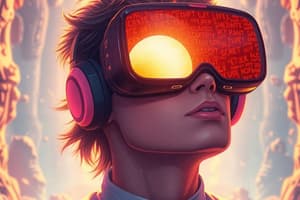Podcast
Questions and Answers
Define Augmented Reality (AR) and give an example of AR technology.
Define Augmented Reality (AR) and give an example of AR technology.
Augmented Reality (AR) is a technology that layers computer-generated enhancements over an existing reality. Example: Snapchat lenses or Pokemon Go.
Define Virtual Reality (VR) and provide an example of VR technology.
Define Virtual Reality (VR) and provide an example of VR technology.
Virtual Reality (VR) is a realistic and immersive simulation of a three-dimensional environment. Example: VR PS5 or Meta Quest.
What is Mixed Reality (MR) and how does it combine elements of AR and VR?
What is Mixed Reality (MR) and how does it combine elements of AR and VR?
Mixed Reality (MR) combines elements of AR and VR to create immersive experiences that blend the real and virtual worlds. In MR, virtual objects are integrated into and responsive to the real world, appearing to be real.
Which sector has the highest usage of AR/VR according to the statistics provided?
Which sector has the highest usage of AR/VR according to the statistics provided?
VR technology simulates multiple senses to make the virtual environment feel real.
VR technology simulates multiple senses to make the virtual environment feel real.
Flashcards are hidden until you start studying
Study Notes
What is AR/VR/MR?
- Augmented Reality (AR): layers computer-generated enhancements over existing reality to make it more meaningful through interactivity.
- Examples of AR: Snapchat lenses, Pokémon Go.
- Virtual Reality (VR): realistic and immersive simulation of a 3D environment, created using interactive software and hardware, experienced or controlled by body movement.
- Examples of VR: VR PS5, Meta Quest.
- Mixed Reality (MR): combines the best of both AR and VR, allowing users to navigate both real and virtual spaces, with virtual objects integrated into and responsive to the real world.
- Examples of MR: Microsoft’s Hololens, Vision Pro by Apple.
Comparison of AR, VR, and MR
- AR vs. VR: AR uses real-world setting, while VR is completely virtual; AR users control presence in real world, while VR users are controlled by the system.
- AR vs. MR: MR takes the best qualities of AR and VR to create an immersive interface that overlays upon the user’s reality, with virtual objects integrated into and responsive to the real world.
Statistics About AR/VR
- Sectors using AR/VR: video games, education, and healthcare.
Applications of AR/VR
- Medicine: training applications, development work (e.g., city planning).
- Education: training applications.
- Entertainment: video games.
- Healthcare: training applications.
How Does VR Technology Work?
- VR systems simulate multiple senses to create an immersive environment.
- Hardware: supports sensory stimulation (sound, touch, smell, heat intensity).
- Software: generates rendered virtual environment, manages VR input/output devices, analyzes incoming data, and generates proper feedback.
VR Hardware
- Personal computer: processes inputs and outputs, renders high-quality graphics, uses GPU for faster computations.
- Input devices: help users navigate 3D worlds.
- Output devices: haptic displays, head-mounted displays (HMD), headphones with spatial audio.
VR Software
- Creates content using computer vision and computer graphics.
- Develops 3D objects in virtual 3D space.
- Manages VR input/output devices, analyzes incoming data, generates proper feedback.
- Software development kits (SDKs): VR game engines, VR content creation, VR visualization software, VR training simulators.
How Does AR/MR Technology Work?
- Components of AR system: camera, sensors (GPS, MEMS), and software.
- Scans captured environment to identify location for overlaying additional information.
- Generates additional information to overlay on real-world background.
- Combines real-world background with overlaid AR graphical data.
AR Hardware
- Sensors: camera, GPS, MEMS (accelerometer, gyroscope, solid-state compass) in modern mobile computing devices (smartphones, tablets).
- Examples of AR hardware: Google Glass Explorer Edition, Microsoft HoloLens, Vision Pro by Apple.
AR Software
- AR app developers use Apple ARKit and Google ARCore SDKs.
- SDKs enable quick and easy creation of AR apps for smartphones and tablets.
Advantages of AR/VR
- In training: enhances learning experiences.
- In education: increases engagement and retention.
- In entertainment and gaming: creates immersive experiences.
- In help and healing: provides therapy and treatment options.
- In architecture and planning: enhances design and visualization.
Disadvantages of AR/VR
- Loss of spatial awareness.
- Eye soreness.
- Seizures.
- Nausea, dizziness, and disorientation.
Challenges of AR/VR
- High cost.
- Limited content.
- Lack of viable business models.
- Health effects.
- VR perceived as gimmick.
- Ethical issues.
- Social impact.
Studying That Suits You
Use AI to generate personalized quizzes and flashcards to suit your learning preferences.



